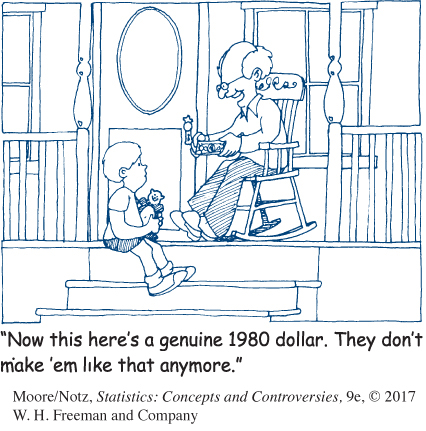
Index numbers
The CPI is a new kind of numerical description, an index number. We can attach an index number to any quantitative variable that we measure repeatedly over time. The idea of the index number is to give a picture of changes in a variable much like that drawn by saying, “The average cost of hospital charges rose 90.2% between 2000 and 2010.” That is, an index number describes the percentage change from a base period.
Index number
An index number measures the value of a variable relative to its value at a base period. To find the index number for any value of the variable:
index number=valuebase value×100
EXAMPLE 1 Calculating an index number
A gallon of unleaded regular gasoline cost $0.992 during the first week of January 1994 and $2.689 during the first week of August 2015. (These are national average prices calculated by the U.S. Department of Energy.) The gasoline price index number for the first week in August 2015, with the first week in January 1994 as the base period, is
index number=valuebase value×100=2.6890.992×100=271.1
The gasoline price index number for the base period, January 1994, is
index number=0.9920.992×100=100
Knowing the base period is essential to making sense of an index number. Because the index number for the base period is always 100, it is usual to identify the base period as 1994 by writing “1994 = 100.” In news reports concerning the CPI, you will notice the mysterious equation “1982–84 = 100.” That’s shorthand for the fact that the years 1982 to 1984 are the base period for the CPI. An index number just gives the current value as a percentage of the base value. Index number 271.1 means 271.1% of the base value, or a 171.1% increase from the base value. Index number 57 means that the current value is 57% of the base, a 43% decrease.